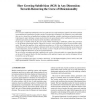Free Online Productivity Tools
i2Speak
i2Symbol
i2OCR
iTex2Img
iWeb2Print
iWeb2Shot
i2Type
iPdf2Split
iPdf2Merge
i2Bopomofo
i2Arabic
i2Style
i2Image
i2PDF
iLatex2Rtf
Sci2ools
120
click to vote
CGF
2002
2002
Slow Growing Subdivision (SGS) in Any Dimension: Towards Removing the Curse of Dimensionality
In recent years subdivision methods have been one of the most successful techniques applied to the multi-resolution representation and visualization of surface meshes. Extension these techniques to the volumetric case would enable their use in a broad class of applications including solid modeling, scientific visualization and mesh generation. Unfortunately, major challenges remain unsolved both in the generalization of the combinatorial structure of the refinement procedure and in the analysis of the smoothness of the limit mesh. In this paper we mainly tackle the first part of the problem introducing a subdivision scheme that generalizes to 3D and higher dimensional meshes without the excessive vertex proliferation typical of tensor-product refinements. The main four qualities of our subdivision procedure are: (i) the rate of refinement does not grow with the dimension of the mesh, (ii) adaptive refinement of the mesh is possible without introducing special temporary cell decomposit...
| Added | 17 Dec 2010 |
| Updated | 17 Dec 2010 |
| Type | Journal |
| Year | 2002 |
| Where | CGF |
| Authors | Valerio Pascucci |
Comments (0)

